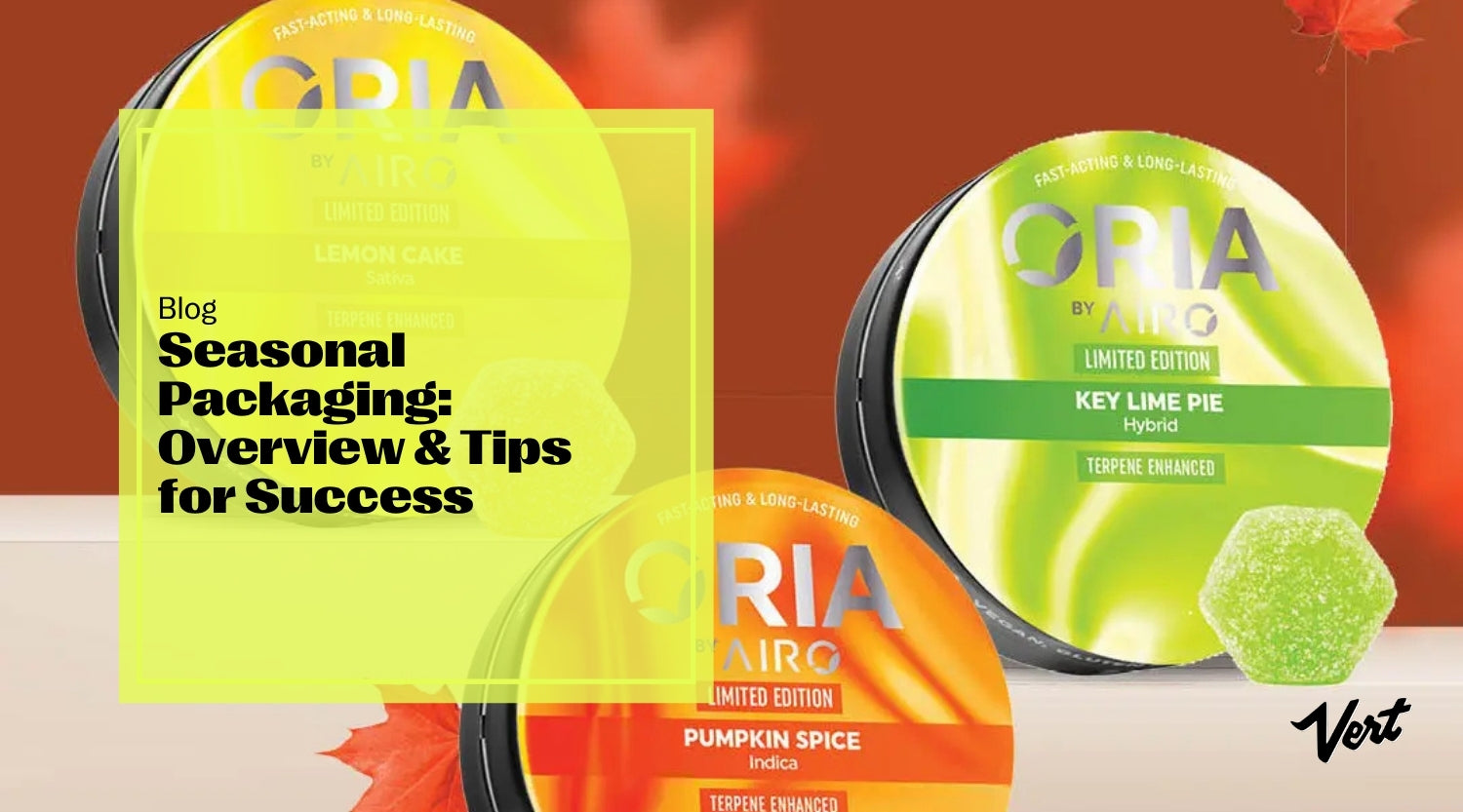Seasonal packaging is a marketing strategy used to alter designs and products to match a particular season or holiday, such as summer or Halloween. Creating seasonal packaging is a way of drawing attention to your brand, with the aim of increasing sales to current customers and attracting new customers.

As many brands are employing this strategy at the same time, marketing and design teams need to be aware of the competition and get creative in how they stand out. Extra care also needs to be taken to avoid some common pitfalls, including unnecessary expenses, inconsistent branding, and supply chain bottlenecks.
Importance and Effectiveness of Seasonal Packaging
Seasonal packaging is important to gain the attention of new customers, cement the loyalty of existing customers, and encourage impulse buying.
Gain New Customers Through Brand Awareness
Making your products stand out via seasonal packaging is a great way to gain new customers who may not have noticed or tried your brand before. There are numerous design elements that increase excitement about your products. Colors, language, and pictures are important, and the use of premium prints and embellishments like metallic foil and raised lettering draws extra attention.
Increase Connection With Your Loyal Customer Base
Seasonal packaging designs demonstrate that you know your target audience and cater to their real-life needs and desires. Do they care about their pets, their loved ones, or particular social issues?
You could have a range of cannabis and CBD products with special packaging for Mental Health Awareness Month, for example, to acknowledge the relevance of this occasion to those in your customer base. Another example is seasonal packaging on nutraceuticals following New Year's, for those starting their health kicks.

Caption: Image courtesy of Elevate on Instagram
Boost Impulse Buying
Seasonal packaging encourages impulse purchases. If you effectively market and package your product to look like the exact thing a customer needs in the current season, they're more likely to grab it off the shelf and take it home. This may produce a one-off sale, or this customer may see the value of your brand and products after experiencing this impulse purchase and try your brand again.
The Do’s When It Comes to Seasonal Packaging
There are many things to keep in mind and many moving parts to coordinate when planning packaging changes for special events and seasons. Here's a list of some of the things to make sure you consider in your planning.
1. Start planning well in advance.
Two-to-six months prior to launch is optimal for planning seasonal packaging, depending on the changes and the scale of your supply chain. Allow an additional two weeks to package and distribute the products at the end.
2. Communicate ahead to avoid supply chain bottlenecks.
It's important to factor in busy seasons and last-minute rushes, so make sure you're communicating transparently and regularly with all businesses involved in the manufacturing, logistics, and marketing processes to prevent supply chain bottlenecks.
3. Coordinate marketing and branding.
Make sure your marketing and branding teams talk to each other, especially if developing a seasonal product to go along with the seasonal branding. Think about your promotional strategy. Does it include sending email newsletters, sneak peaks, general advertising, and online influencers to mention your products? Can you secure a prominent position in your retail outlets?
4. See what competitors are doing.
Check out the competition and make sure to find your own niche, so as not to look the same as everyone else and get lost in the sea of packaging.
5. Use general language to maximize relevance.
Use general terms like “spring” instead of “Easter.” That way, your packaging is still relevant after Easter Sunday has passed. Make sure your imagery lines up with the language used, to be relevant to the broader season.

6. Ensure Quality.
Quality packaging should continue to be used as usual. This maintains the standard your customers are accustomed to and helps keep brand loyalty. Safety is also vital to maintain, with relevant products continuing to come in child-resistant pouches that look stylish on the shelves and preserve the necessary level of protection.
7. Keep Branding Consistent.
Brand recognition is important to maintain as part of your seasonal packaging designs. Customers should still be able to easily pick your brand off the shelf, and you want your brand identity to be imprinted in the minds of new customers during this period. This increases their chance of choosing your products in the future.
8. Create Seasonal Displays.
Create displays to be set up at prime locations within the store or at the checkout, to gain consumer attention and encourage impulse buys. Think about how you could use custom boxes in your displays. These also serve as an extra surface to print your logo on, as well as festive designs.

9. Tailor Your Strategy to Your Target Audience
Think about your target audience. Not all products need seasonal packaging for every occasion.
Mothers are more likely to want natural soaps and cosmetics than other groups, so in the lead up to Mother's Day, start putting thought into packaging these products as gifts. Adding some ribbon or creating a whole gift box will increase the perceived value of the products and potentially boost sales.
Christmas might be a better time to create hype around pet products, with a limited-edition dog treat created for the occasion.
10. Use Color Psychology
Select colors that speak to your target culture and gender. Color psychology differs between cultures, and studies also show that different genders prefer different colors.
11. Keep Packaging Sleek.
Sleek designs provide both a more cost-effective option for seasonal packaging production and allow for more units of product on the same amount of shelf space. To hit a few marks in one, flexible packaging might be just the thing.
Gift packs usually come in corrugated shippers, and though these are synonymous with gift packs—and for good reason—it's also what other brands are doing, and takes up a certain amount of shelf space.
Imagine now, a large stand-up pouch with festive and appealing designs, containing a mix of smaller products such as herbal teas in flat pouches, sachets of energy drink powders in single serves, and beautifully wrapped protein bars in mixed flavors. This simple pouch creates a gift pack of product samples that both promotes a variety of flavors while keeping packaging costs down and standing out from the competition.
12. Consider Limited Edition Packaging
Limited edition packaging creates repeat purchases. We've all seen the packets of choc chips that come with a cookie recipe on the back, but what if you could use your packaging to create a collectible and drive sales? Adding something special to your seasonal packaging that changes slightly each year would be a powerful tool to build an emotional connection and create loyal customers.
Think of a poem about inner beauty on the back of cosmetic products, a recipe suggestion that comes on protein powder packs, or a poster of a beautifully drawn image inside the natural soap packaging. Do you remember the old 'Pears Soap' posters that many folks saw on the bathroom walls of their Grandparents' houses growing up?
The Don’ts When It Comes to Seasonal Packaging
Avoid these common seasonal packaging mistakes to maximize the profitability of your designs.
1. Don’t Overstock Seasonal Products.
Avoid overstocking seasonal products. Make sure that you allow for extra sales, but you don't want to have a large amount of stock left over that has to be sold at discount prices—affecting your profit margins—or written off altogether.
2. Don’t Be Overly Specific
Avoid being too specific in seasonal packaging designs. Saying “Halloween” instead of “fall” on your spice-flavored herbal tea means that those products can't be sold after Halloween is over. If the products have a long shelf life, and you don’t specify the year on the packaging, they could even be kept until the following fall and sold again.
3. Don’t Target Irrelevant Holidays.
Avoid promoting holidays that aren't relevant to your customer base. Promoting men's aftershave for Mother's Day not only doesn't make sense, but it's likely not going to garner sales, leaving you with excess stock to shift and wasted packaging expense.
4. Don’t Make Your Packaging Unrecognizable.
Changing packaging colors too much alters your existing branding identity. It's understandable to want to use festive colors to really get into the spirit, but do it in a way that doesn't alter the color palette your customers recognize as authentically yours.
5. Don’t Overspend.
Don't overspend on seasonal packaging design or manufacture. Things don't need to be overdone, flashy, or complicated to produce excitement in customers. In fact, sometimes a simple style increases the look of luxury.
Find the line between doing enough to enhance your product's saleability while not overdoing it. Spending more than necessary on complicated packaging reduces your profit margins and increases the chances of things going wrong during manufacturing.
6. Don’t Leave Seasonal Packaging to the Last Minute.
Don't be unprepared. Not leaving enough time before product launch leads to things being rushed, mistakes being made, timing of logistics being missed, a lower quality product, and unnecessary expense.
7. Don’t be a Copycat.
Don’t mimic competitors’ seasonal packaging. See what they're doing, then stay true to your brand's values and aesthetics. There's a reason your customer base comes back to your products, so trust that brand consistency will maximize repeat purchases.
Examples of Seasonal Packaging
The Toblerone image below shows different ways of making the package seasonal in both specific and more general ways. Most are Christmas themed, while the white chocolate bar is winter themed, making it saleable for longer and to a wider audience.

This Special K box demonstrates how to market a limited edition product, while also making it relevant to the general season—fall instead of Halloween—keeping the product saleable all season long.

Wrap Up Your Success
Seasonal packaging is an essential part of your marketing calendar and a great way to connect with loyal and new customers. There are many benefits to using creativity and different materials to draw attention to your trusted products.
These packaging options will foster customer interest and loyalty when they reflect your brand's mission and values. Show your customers what your brand is really about with creative and thoughtful seasonal packaging designs this year.



Leave a comment
This site is protected by hCaptcha and the hCaptcha Privacy Policy and Terms of Service apply.